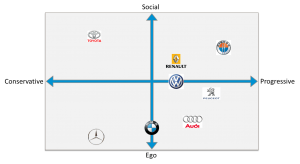*Positioning
Brand strategy in 5 steps

What is the actual difference between brand strategy and positioning? After reading this article, you will understand the difference between these two concepts and how to translate a brand strategy into positioning.
Difference between brand strategy and positioning
Brand strategy and positioning are closely related. Brand strategy is the way a brand (or brands) is utilized to achieve (business) objectives. Positioning, on the other hand, is the act of occupying a unique position in the mind of the consumer compared to competitors. Naturally, these two concepts go hand in hand when it comes to success for your brand and organization.
In this article, we will explain how to translate your brand strategy into a distinctive positioning. If you want to learn more about brand strategy, we also wrote a comprehensive article on that.
From brand strategy to positioning
For the sake of simplicity, we assume that you have a solid brand strategy in place. We are focusing on presenting distinctively—positioning.
Step 1: Mapping Competitive Positioning
To map the market, particularly the positioning of competitors, we use our own positioning matrix. We typically use the degree of progressiveness and ‘sociality’ of competitors’ marketing/positioning as both axes. By mapping the marketing activities of the key competitors and placing them in the matrix, a clear market overview emerges. If other factors are more relevant in your market, you can use them as axes as well.
Step 2: Objectively Determine Your Own Position
Now that you have a good understanding of the competition, where do you stand? Place your brand on the matrix based on current efforts, and you can view the situation from a different perspective. It’s essential to think not just from your perspective but from the viewpoint of your target audience. If necessary, ask a few customers what they think of your brand. The major pitfall here is that companies often fail to do this objectively and instead portray themselves as they would like to be seen.
Step 3: Identify Opportunities for a Unique Positioning
Now that you’re on the matrix, you can easily identify where there’s room to position your brand uniquely. Often, a market is composed of ‘penguins,’ companies that mainly watch each other, and they all end up in a certain quadrant. Identify places that are ‘open’ and associate distinctive behavior with this ‘positioning.’ To make a real choice, we recommend developing at least three free positions.
Step 4: Determine a Remarkable Positioning
Now that we have a list of ‘free’ positions and the associated behavior, we use the brand strategy to tailor each position specifically for your brand. These often present mental challenges because one of the pillars of your brand strategy, for instance, might be innovation, and then it’s difficult to think about a conservative way of communicating. But it’s precisely these apparent contradictions that result in an interesting and remarkable positioning!
Step 5: Implementation
We could write an entire book about this last step because coming up with ideas is one thing, but executing them is quite another. The success of both brand strategy and positioning depends on whether your colleagues can understand and embrace them. They must put them into practice and prioritize them in every customer interaction. Your task is to provide them with the explanation, training, resources, and support they need. So, also ask yourself: How does this advertisement contribute to the story that my colleagues tell our (potential) customers?
Now that you can concretely articulate the difference between brand strategy and positioning, you’re able to make the transition from brand strategy to positioning. The steps mentioned are, of course, unique for every company and market, and you’ll encounter unique challenges and questions for your brand during this process. Please let us know if we can assist you with this.
